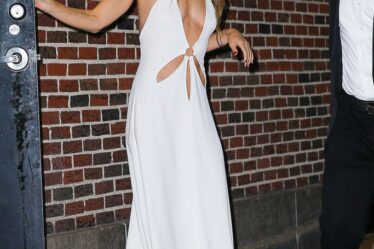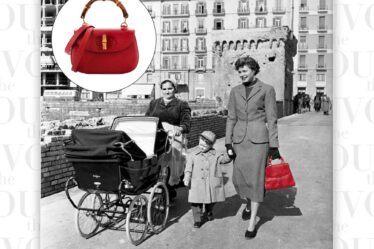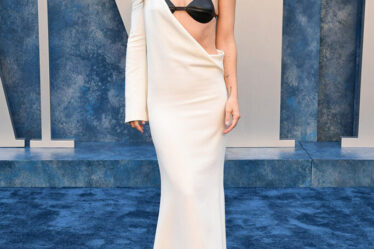
PARIS — Fashion’s giants truly flexed their muscles on Tuesday, with LVMH’s Dior and Kering’s Saint Laurent transforming the locations for their shows with jawdropping degrees of creativity — and a corporate largesse one can scarcely conceive of when every other index in the world is courting catastrophe. At Dior, Maria Grazia Chiuri commissioned artist Eva Jospin to create a huge baroque grotto which reached to the ceiling of the showspace. Though it was actually made from cardboard, it had all the grandeur of a royal folly (from afar at least, which is exactly where most of the audience was — this was not a presentation which will be remembered for its good sight lines). The Saint Laurent show took place, as usual, in the basin of the Trocadéro, across from the Eiffel Tower, but the whole place had been specially tiled and a huge fountain had been erected in the centre. It looked like it had been there for centuries, though it was all sitting on scaffolding.
Both grotto and fountain were obviously startling — and extremely expensive — illusions. More to the point, they were testament to a monumental transformation. Both Dior and Saint Laurent have long since dispensed with the first names of their founders. Such familiarity is irrelevant in fashion’s New Imperial Age, where the apotheosis of the brand guarantees that it is Dior! and Saint Laurent! which are the marquee names, rather than the designers responsible for their creative direction. But, of course, it’s those designers — Chiuri and Anthony Vaccarello — who have steadily evolved the brand profiles that provide the platform for empire-building, and they’ve done it by managing to stir their own obsessions into the billion dollar mix.
In Chiuri’s case, she has used each of her collections to reflect on women of achievement: artists, writers, activists. But none of them was the match of Catherine de’ Medici, Tuesday’s inspiration. Born in Florence, she married Henry, second son of the French king Francis I, in 1533, and essentially civilised the French by showing up in Paris with the Italian cooks and seamstresses who were the genesis of haute cuisine and haute couture. The French were not happy, especially when, following her husband’s death, Catherine went on to wield an extraordinary amount of power for a woman in such turbulent times. It was mightily tempting to see a parallel with Chiuri’s own experience as an Italian woman in France’s contemporary court, the fashion world. She scoffed at the thought. It was Catherine’s innate understanding of the power of fashion that fascinated her.
After her husband’s death, Catherine dressed in black for the rest of her life. Conveniently, it was also a shade that broadcast her status (black being the most expensive dye, therefore only available to the wealthiest). She was short, so she introduced the choupette, the platform shoe, to the French court. She felt the added height gave her importance. She also introduced lingerie. And her seamstresses taught the French about lace and embroidery. You could trace all those elements through Chiuri’s new collection. A conversation between France and Italy, she called it, but there was also a personal dialogue between the more architectural essence of French construction and Chiuri’s own background. “Lighter, more fragile, more natural,” so she said. The contrast was obvious from the first look. The exaggerated pannier silhouette was more historical than anything she’s offered in the past, but it was draped in a black lace woven from raffia, paired with a simple bra top, and accessorised with a ribbon tied round the midriff, a poignant clincher. If Chiuri had Catherine de’ Medici on her mind, she was also thinking of Mustang, a Turkish film she’s loved recently. The story may be a melancholy Virgin Suicides-like tale of four sisters exorcised by their community, but it spoke to her about the way in which women together can present a formidable front. Something magical in that witchery (which is why Picnic at Hanging Rock was also on the mood board).
Chiuri said when she goes to schools to speak to students, she finds many of them riven by a love/hate relationship with fashion because of the power of the conglomerates. “When I was young, I saw fashion as an expression of freedom,” she said. “Now I see fashion can be about expressing your freedom, but also your power too.” The abiding impression of Chiuri’s show was the hyper-feminine prettiness of lace and bloomers and corsets and embroidered flowers sparked by the intense, unblinking, heavily shadowed gaze of her new model army.
There was a similarly militant edge about the women on Anthony Vaccarello’s catwalk for Saint Laurent as well. Imagine a platoon of them walking down the street in those broad-shouldered, floor-sweeping leather coats. We haven’t seen their like since Claude Montana’s ‘80s heyday. That, and the ‘90s, were the decades that imprinted themselves on a teen Tony. In fact, his new collection’s main inspiration — the legendary choreographer Martha Graham — actually came to him through Madonna’s obsession with Graham, as expressed in videos such as 1993′s “Rain..” The tubular jersey costume Graham designed for herself for her 1930 performance “Lamentation” was Vaccarello’s starting point, rather than the Yves-something-or-other that is his usual kickoff, though archivists might recognise the capuces, the hoods, that were one of YSL’s design flourishes in the mid-80s.
But if the collection was further away than usual from Yves’s actual design legacy, (“less first degree”, he conceded), Vaccarello also insisted that he was more attitudinally attuned than ever in his celebration of female power. Of course it was those coats — even if he himself found the suggestion of militancy too aggressive — but it was also the bodies encased in the long jersey tubes underneath that struck him as a modern way to celebrate women. Once, in the days of Anja Rubik, his dresses were polarising in their abbreviation. Here, the legs were covered but the second-skin knit sheaths made them even more suggestive in their movement. It was the kind of chaste/carnal tension that Yves exploited to great effect (Belle de Jour its cinematic apogee). And it was heightened by a fabulous colour palette, muted but sumptuous. “It’s my interpretation of freedom,” Vaccarello said. “The colour and attitude of Saint Laurent in Martha Graham’s jersey tube.” The show itself might have veered towards monomaniacal in its insistence on the one idea — the huge structured coat over the simple tube — but it was an undeniably powerful image. And God only knows the message of empowerment bears repeating over and over as long as the patriarchy is doing its level best to turn back the clock.



